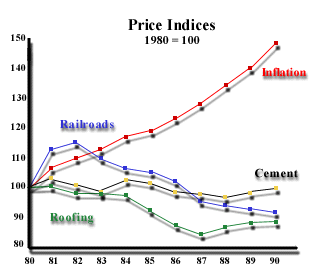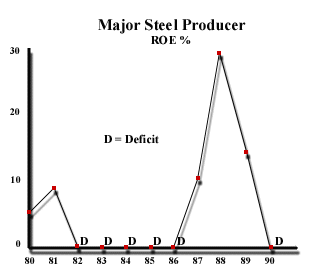MYTH OF THE HOCKEY STICK
by Donald V. Potter
Market hostility is like a bad cold: the condition feels terrible, and – unfortunately – it cannot be cured until it has run its course.
That course is much longer than company leaders want, or believe. Once a market enters hostility, it will stay in hostility on average for over 10 years. For some industries the situation persists even longer: steel has been hostile for more than 20 years.
Deceived by Upticks
“Prices do not keep up with inflation.”
Managers do not plan for long periods of hostility, however, because they are persuaded again and again that hostility is nearly over. They see an improvement in industry returns and project it to be the beginning of a turn-around that might take the industry to new levels of prosperity. They envision the classic “hockey stick.”
The assumption of an improvement in industry prices usually drives the “hockey stick.” But, from the early stages of hostility, real improvement in price is a long time in coming. Prices in hostile markets usually fail to keep up with inflation. If plotted on a line chart, prices for a typical industry would be seen to rise markedly for several years, to plunge sharply once hostility begins, and then to continue in a basically horizontal line throughout the trough. That basic horizontal pattern is demonstrated by the industries shown below:

Managers can be misled because sometimes this basic pattern is interrupted by an uptick- a brief improvement in industry returns. The upturn is real, but short-lived.
An uptick is illustrated below by the return pattern of a major domestic steel company. Domestic steel demand increased dramatically in 1987, leading to three years of returns above long-term levels. As capacity adjusted, hostility returned. These upticks happen because, despite hostility, the basic market forces of supply and demand are at work. Even during hostility, most markets still show real growth. In three quarters of hostile markets, unit sales per year are actually increasing.

But a market in hostility behaves like one that is shrinking. The growth of low-priced players will result in cutthroat competition, “irrational” pricing, and changes in customer buying patterns. In other words, suppliers will be scrambling for share just as they would if the market size were declining. From time to time, demand will exceed supply, and suppliers may have a brief respite from the market pressure. But then new capacity quickly comes on line to meet demand, and low margins return.
Redefining The “Normal” Market
“Few managers can outwait hostility.”
These small upticks can do considerable harm if they convince business leaders that hostility is a short-term condition. The reality is that market hostility of average duration exceeds the career tenure of many top managers. Few can outwait hostility. It will form the framework within which all their business decisions must be made.
As price competition becomes more acute, companies must continue to invest to outperform their rivals. That investment should not be postponed in the belief that times will soon be better. They won’t – and when they are, it may be too late.
Most companies plan to a five-year horizon. In five years, it is possible to build a plant, launch a new product line, enter or exit a market. Five years is only half the duration of most periods of hostility. By accepting market hostility as the new “normal” condition, leaders can get on with efforts that will improve their company’s competitive situation during hostility and, eventually, when hostility is over.
Closing Thought
A company growing faster and making better returns than its industry is doing well. Sometimes parent companies and boards of directors, believing otherwise because profits are not as high as other businesses, refuse to support the company. This only makes the situation worse.
(Note: This Perspective was written in the context of the economy in 1993. While some of the companies may have changed their policies or indeed no longer exist, the patterns they exhibit still hold today.)
| Recommended Reading |
| For a greater overall perspective on this subject, we recommend the following related items:
Analyses:
Symptoms and Implications: Symptoms developing in the market that would suggest the need for this analysis.
*** |
